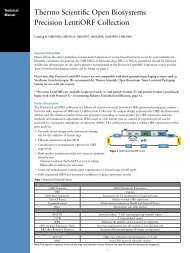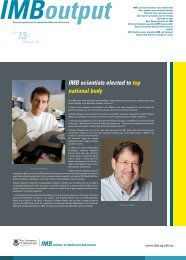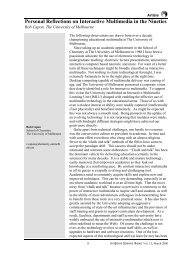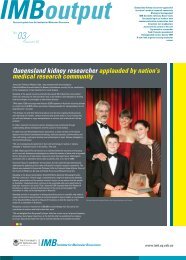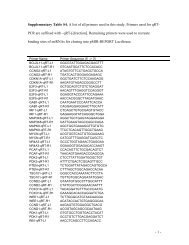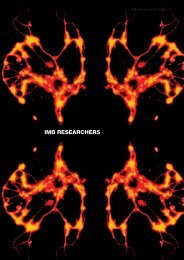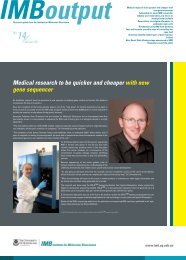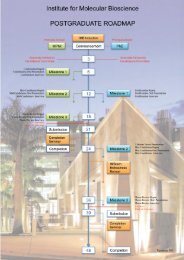2010 Annual Report - Institute for Molecular Bioscience - University ...
2010 Annual Report - Institute for Molecular Bioscience - University ...
2010 Annual Report - Institute for Molecular Bioscience - University ...
You also want an ePaper? Increase the reach of your titles
YUMPU automatically turns print PDFs into web optimized ePapers that Google loves.
imb annual report <strong>2010</strong><br />
80<br />
consideration. This is a very powerful<br />
approach to biology which enables<br />
gene function to be elucidated based<br />
upon the high-throughput analysis of<br />
phenotypes (“phenomics”).<br />
AUSTRALIAN STEM CELL CENTRE<br />
The Australian Stem Cell Centre (ASCC)<br />
is a national research and funding<br />
facility set up by the ARC, the Victorian<br />
Department of Industry, Innovation and<br />
Regional Development, and the Federal<br />
Department of Education, Science and<br />
Training. The ASCC is primarily based<br />
at Monash <strong>University</strong>, but through the<br />
guidance of the Scientific Management<br />
Advisory Committee (SMAC) and a<br />
process of due diligence, the ASCC<br />
funds research which falls within its<br />
core expertise plat<strong>for</strong>m areas or its<br />
therapeutic focus areas. The IMB<br />
has very close links with the ASCC.<br />
Professor Brandon Wainwright served<br />
on the Board from April 2009 until<br />
October <strong>2010</strong>. Professor Melissa Little<br />
spent a period as Chief Scientific Officer,<br />
responsible <strong>for</strong> developing strategy,<br />
scientific review and management, and<br />
developed a Queensland division of the<br />
ASCC based at UQ. She is a member<br />
of the Centre’s Senior Scientific Faculty,<br />
a group of eminent and internationally<br />
regarded Australian researchers who<br />
monitor scientific progress, provide<br />
advice to the ASCC and act as the<br />
key public scientific spokespeople.<br />
The Centre distributes its funds to<br />
collaborative groups of researchers in<br />
four key areas, known as streams, of<br />
stem cell research. Professor Little is<br />
Deputy Leader of Collaborative Stream<br />
4: Adult Stem Cell Program. She is also<br />
leader of a module within this stream<br />
that aims to further characterise the<br />
origin and properties of endogenous<br />
renal MSCs and investigate their role in<br />
responding to renal damage. Professor<br />
Little is leader of another module,<br />
“Regenerative Therapies <strong>for</strong> Renal<br />
Repair”. This module is in Stream 3:<br />
Pluripotent Stem Cell Differentiation.<br />
Professor Little is screening <strong>for</strong> novel<br />
chemical compounds that can direct<br />
stem cells to <strong>for</strong>m a kidney. One of<br />
Professor Little’s PhD students, Caroline<br />
Hopkins, won an International Travel<br />
Award from the ASCC, designed to<br />
allow junior researchers to attend<br />
international stem cell meetings.<br />
Professor Sean Grimmond is also funded<br />
by the ASCC. He is leader of a module<br />
in Stream 2. This stream focuses on<br />
understanding reprogramming of cells<br />
and the introduction of pluripotency.<br />
Professor Grimmond’s module is<br />
defining the underlying genetics of<br />
these processes. He is also a Chief<br />
Investigator on a project supported<br />
by the ASCC’s Strategic Development<br />
Fund. He, along with Dr Christine Wells<br />
from Griffith <strong>University</strong> and Professor<br />
Doug Hilton from the Walter and Eliza<br />
Hall <strong>Institute</strong>, is developing a database<br />
containing multiple datasets of genetic<br />
in<strong>for</strong>mation across stem cell lines to help<br />
Australian scientists to better compare<br />
the chracteristics of different types of<br />
stem cells.<br />
NETWORK FOR PANCREATIC<br />
ORGAN DONORS WITH DIABETES<br />
(NPOD)<br />
nPOD is an initiative of the Juvenile<br />
Diabetes Research Foundation<br />
International (JDRF) and brings together<br />
organ procurement organisations,<br />
academic institutions and leading<br />
diabetes researchers from Europe and<br />
America. IMB’s Dr Brad Marsh is an<br />
investigator in the Pathology category.<br />
Dr Marsh studies the 3D characterisation<br />
of islet cell function and dysfunction.<br />
nPod aims to improve the procurement<br />
of pancreatic tissue specifically from<br />
patients and donors at high risk of<br />
developing type 1 diabetes. It is the first<br />
trial of its kind anywhere in the world<br />
and it is hoped that it will improve our<br />
understanding of the onset and progress<br />
of type 1 diabetes. Together with<br />
Professors Thomas Kay at St Vincent’s<br />
<strong>Institute</strong> and Peter Colman at the Royal<br />
Melbourne Hospital, one goal of the<br />
nPOD program is to establish a similar<br />
initiative among groups leading type 1<br />
diabetes research within Australia.<br />
QUEENSLAND FACILITY FOR<br />
ADVANCED BIOINFORMATICS<br />
(QFAB)<br />
QFAB is based at the IMB and was<br />
established in 2006 with a $1.9 million<br />
Queensland State Government grant<br />
that has been leveraged to provide $9<br />
million worth of resources available<br />
<strong>for</strong> client projects. It supports the<br />
bioin<strong>for</strong>matics requirements of the<br />
biotechnology, pharmaceutical,<br />
clinical and research communities by<br />
providing broad expertise and access<br />
to large databases, high-per<strong>for</strong>mance<br />
computing and storage, and to specialist<br />
software and services. Since beginning<br />
operations, it has completed over 50<br />
projects with another 15 underway. IMB<br />
projects on which QFAB has worked<br />
include helping to find the basis <strong>for</strong><br />
childhood obesity (KOALA), building a<br />
database <strong>for</strong> spider venom research and<br />
analysis of a transposon-based <strong>for</strong>ward<br />
genetic screen. QFAB has helped<br />
researchers attract $52.7 million in grant<br />
funding to Queensland.<br />
RIKEN/FANTOM<br />
RIKEN is the <strong>Institute</strong> <strong>for</strong> Physical and<br />
Chemical Sciences of the Japanese<br />
Science and Technology Agency, and<br />
a major site of genomics research in<br />
Japan. The RIKEN Genome Sciences<br />
Centre is based at Yokohama, Japan’s<br />
second-largest city, and Wako, both<br />
in the Tokyo area. In the late 1990s,<br />
RIKEN established a program aimed at<br />
elucidating the complete transcriptional<br />
output of the mouse. More recently,<br />
the program has shifted focus towards<br />
the elucidation of transcriptional control<br />
networks. Both activities have involved<br />
the establishment of large international<br />
consortia, firstly the FANTOM consortium<br />
(Functional Annotation of Mouse), and<br />
more recently the Genome Network<br />
consortium. The consortium has<br />
previously published a comprehensive<br />
analysis of the human and mouse<br />
transcriptome and a series of papers<br />
on gene control in mammals. IMB<br />
researchers were involved as authors<br />
and senior authors on these papers.




